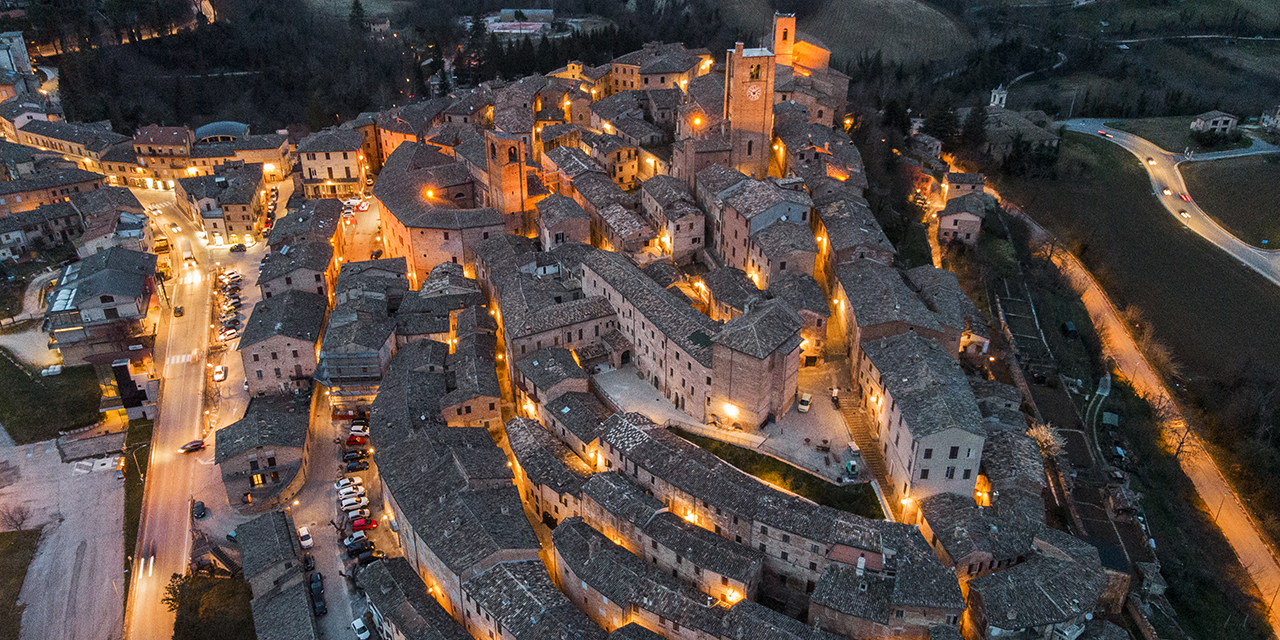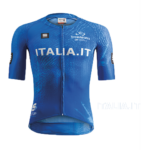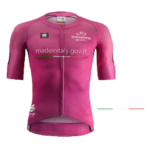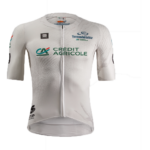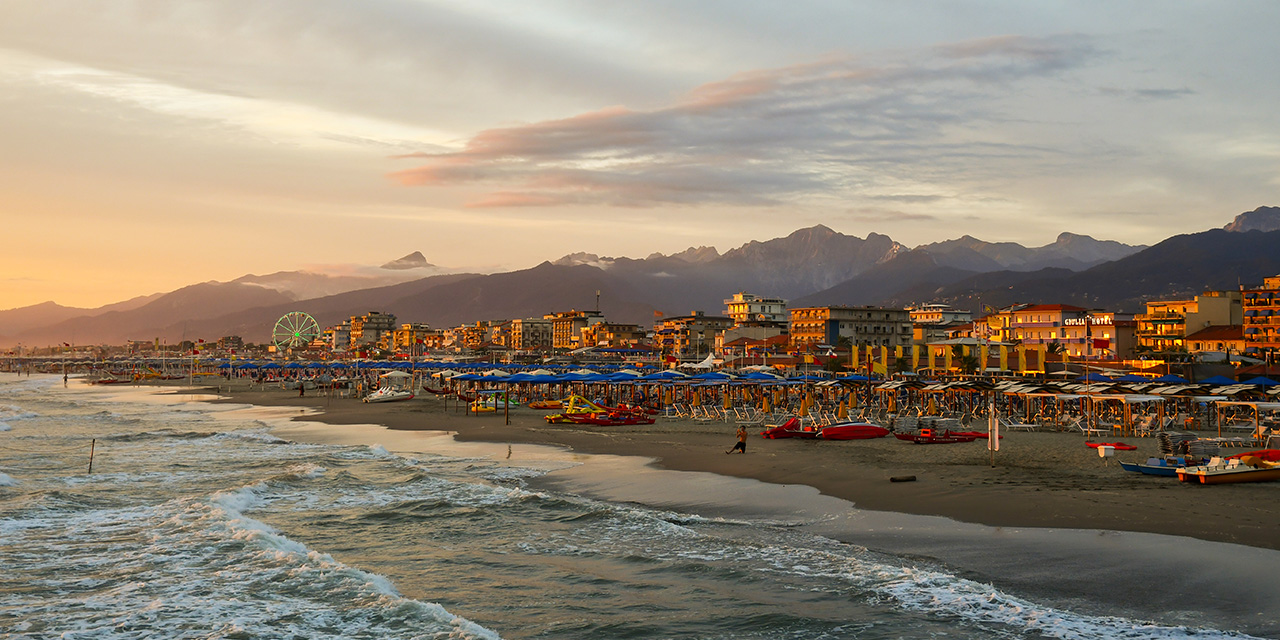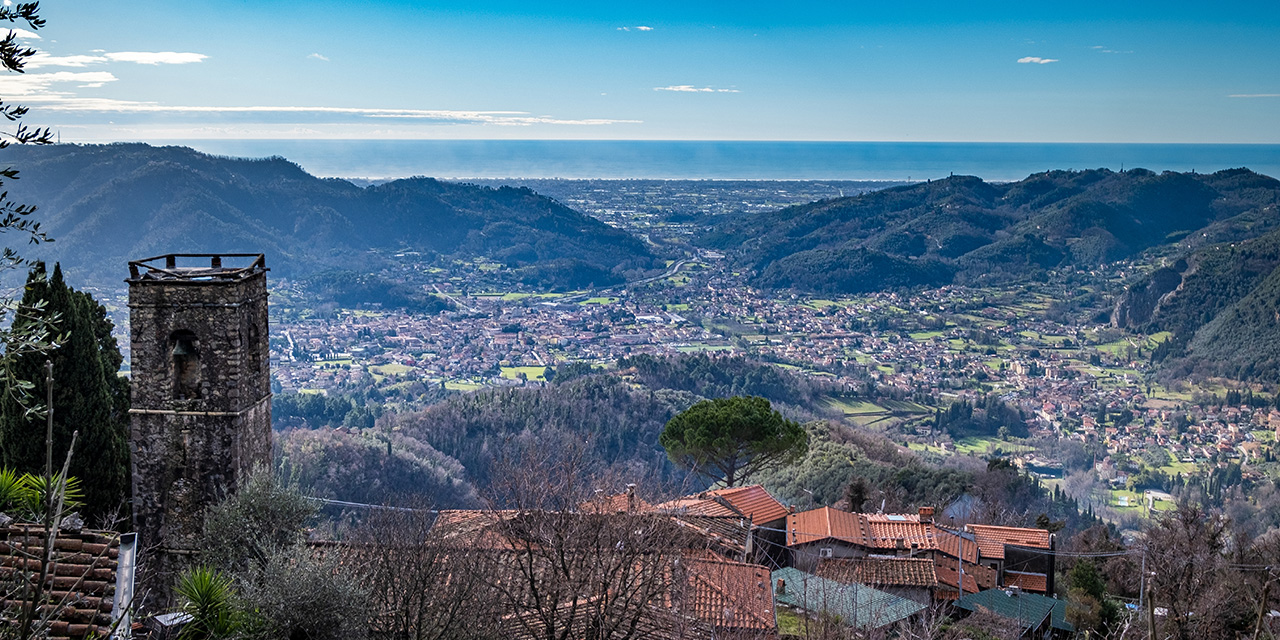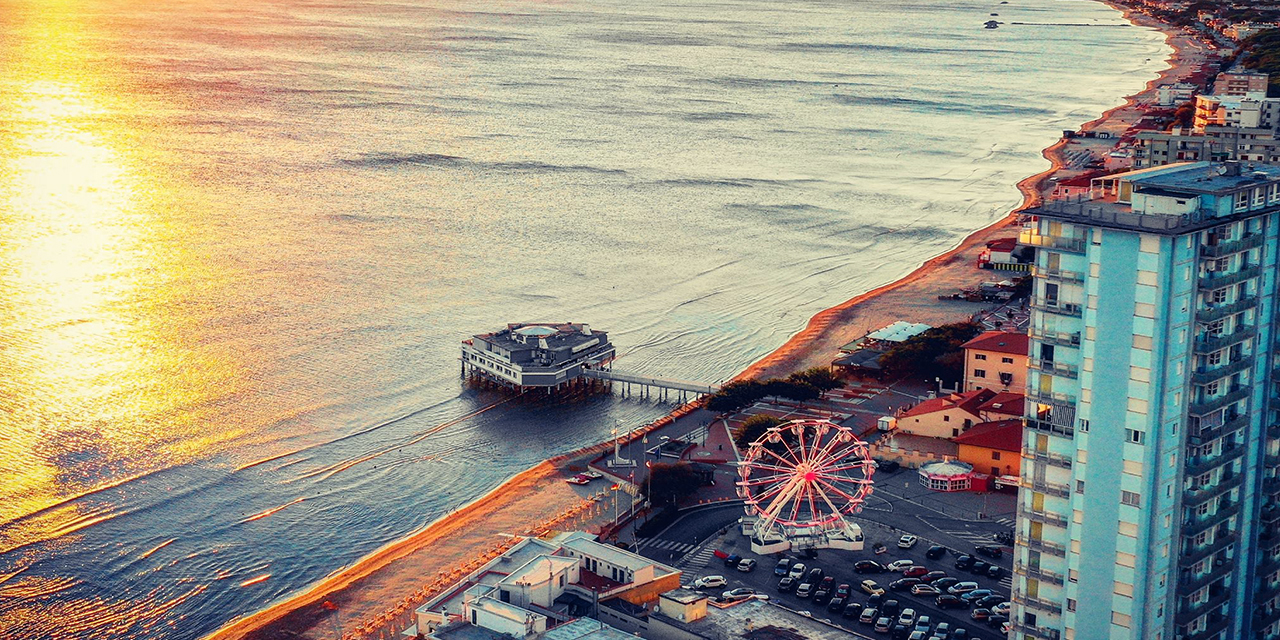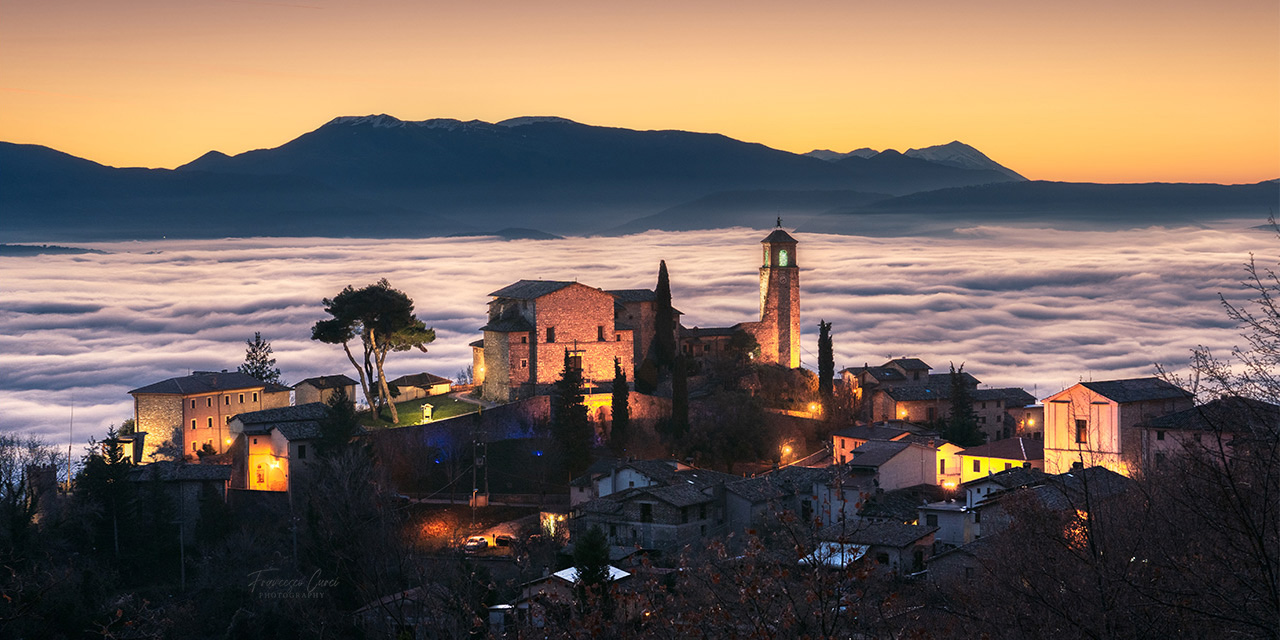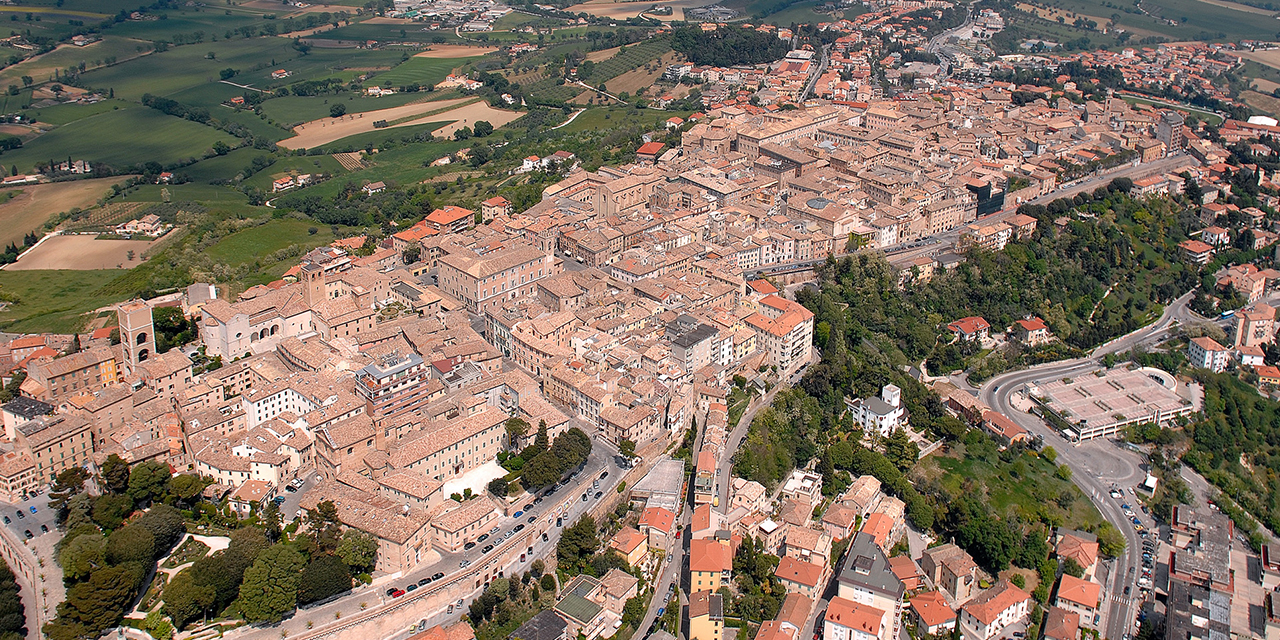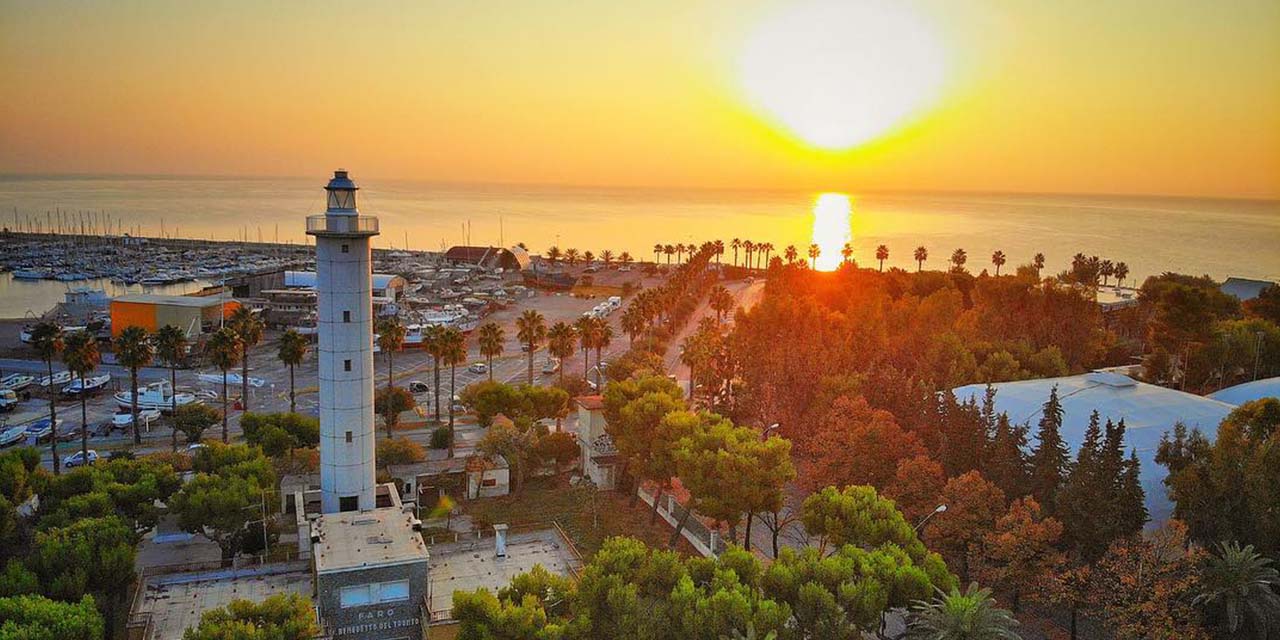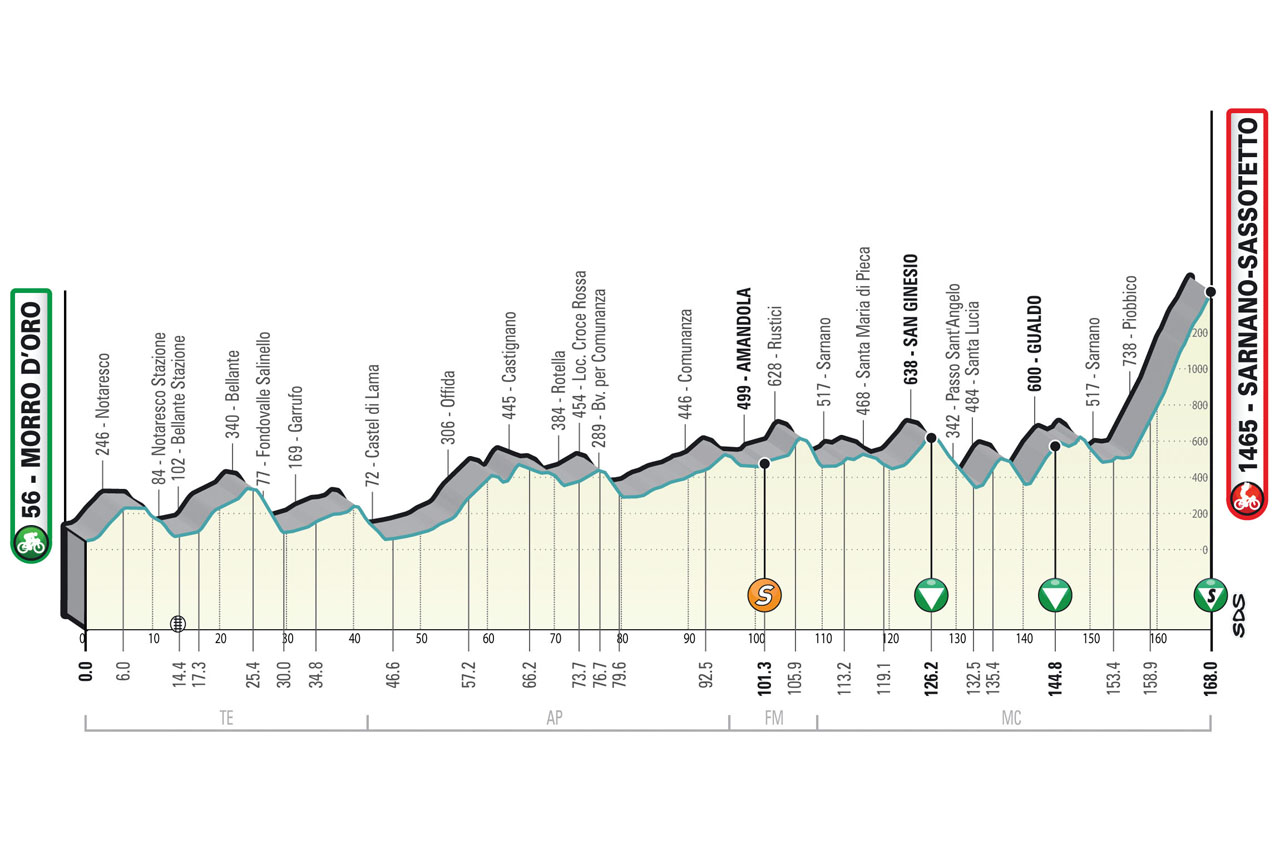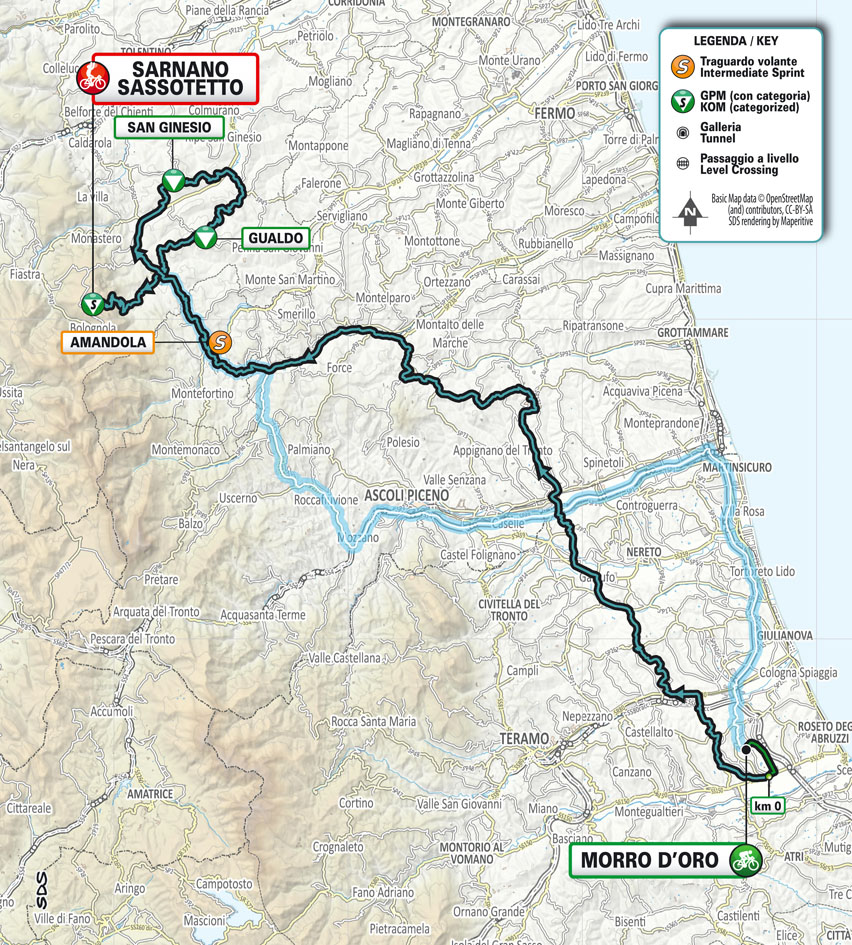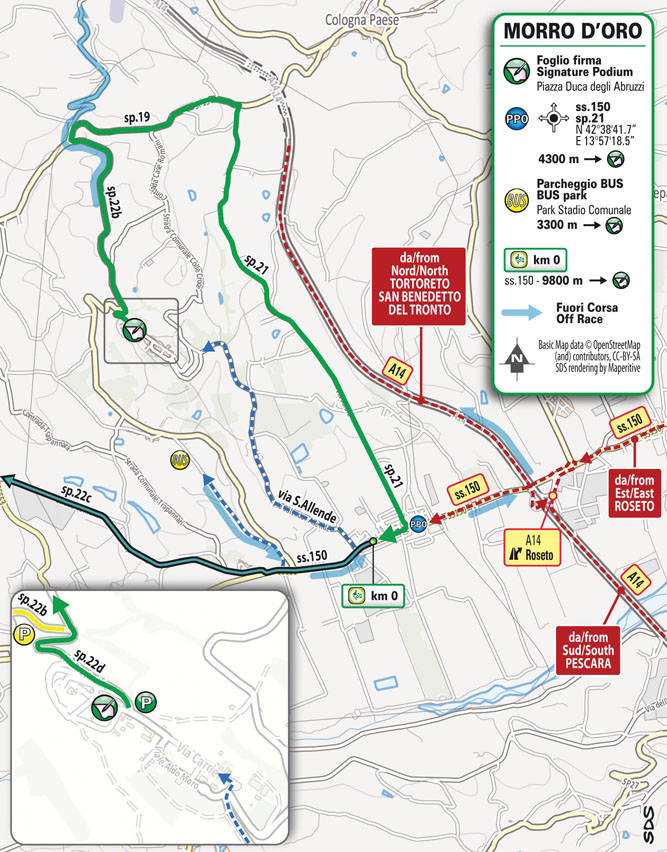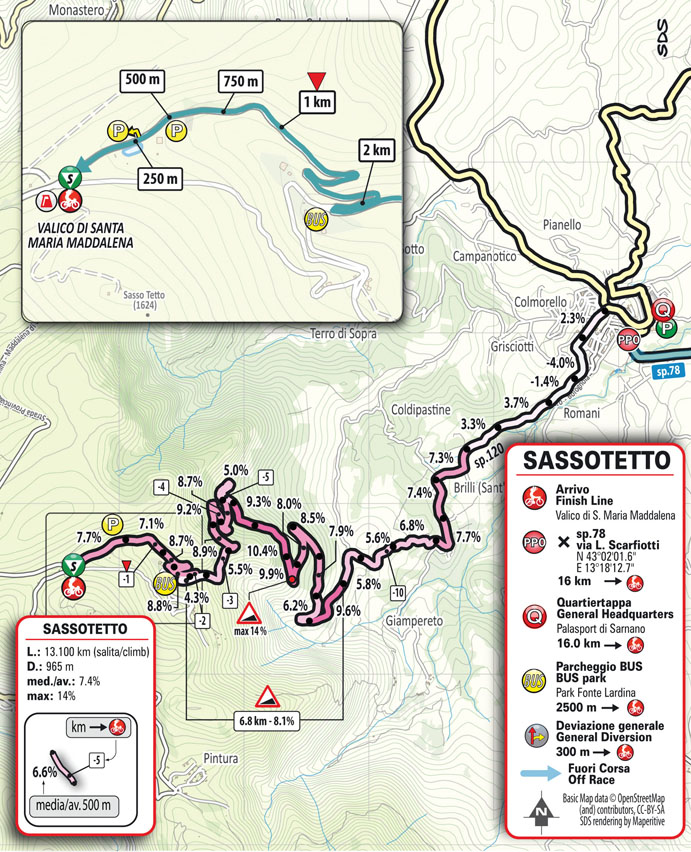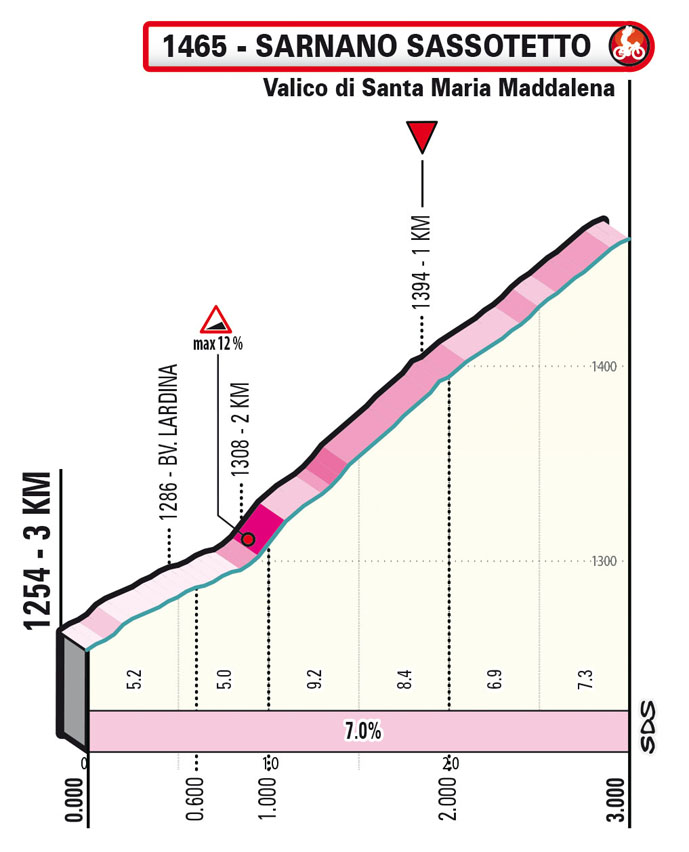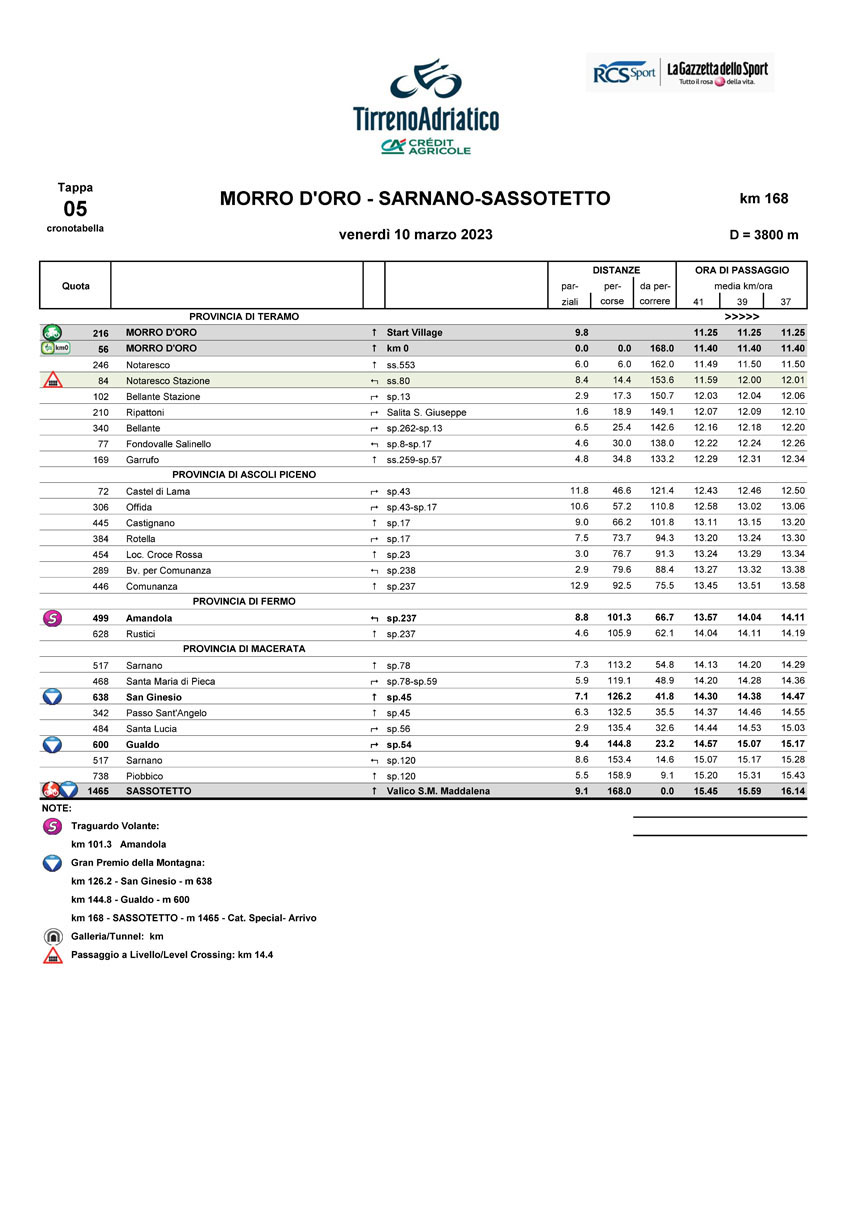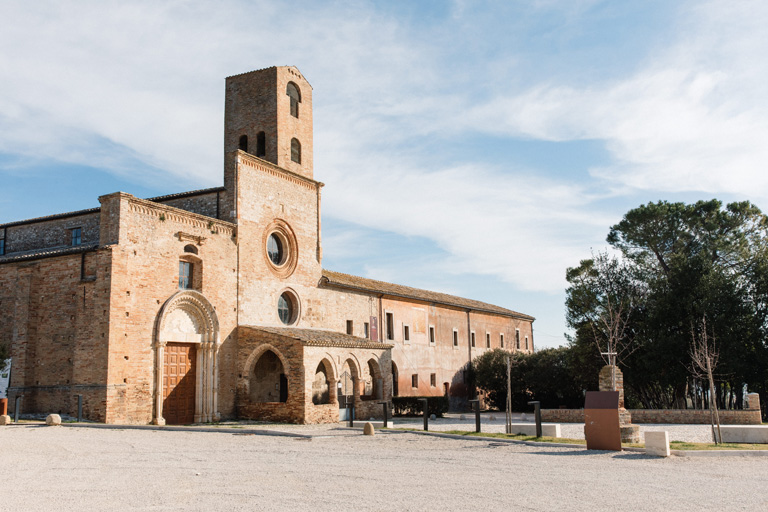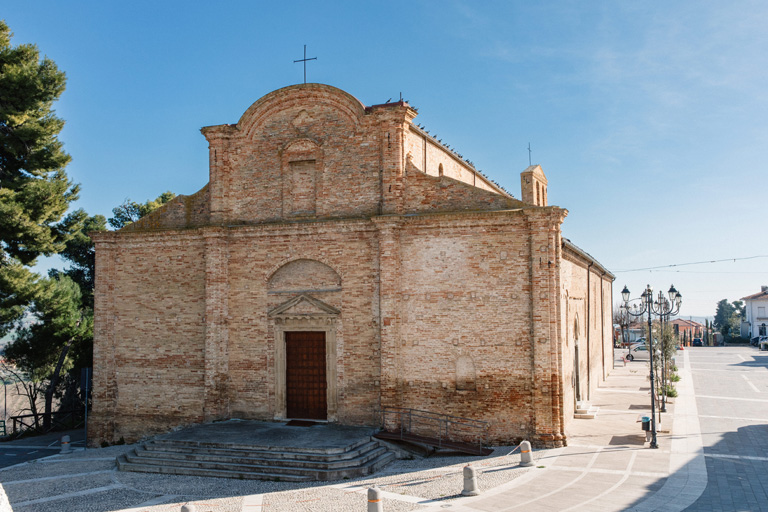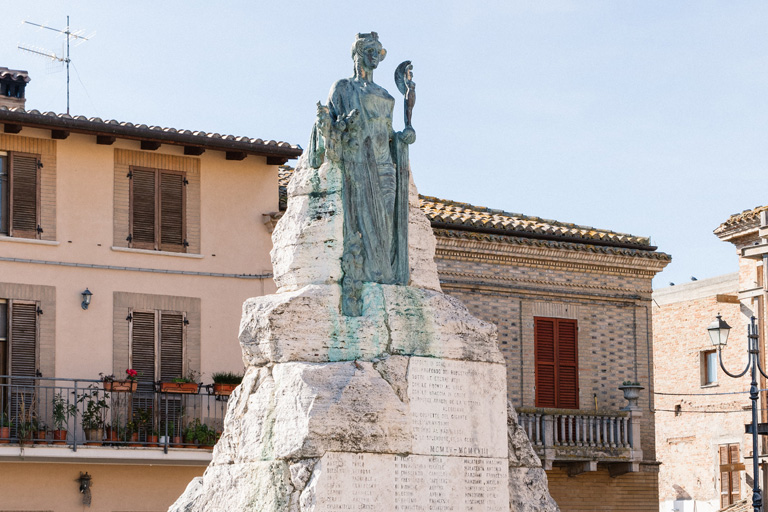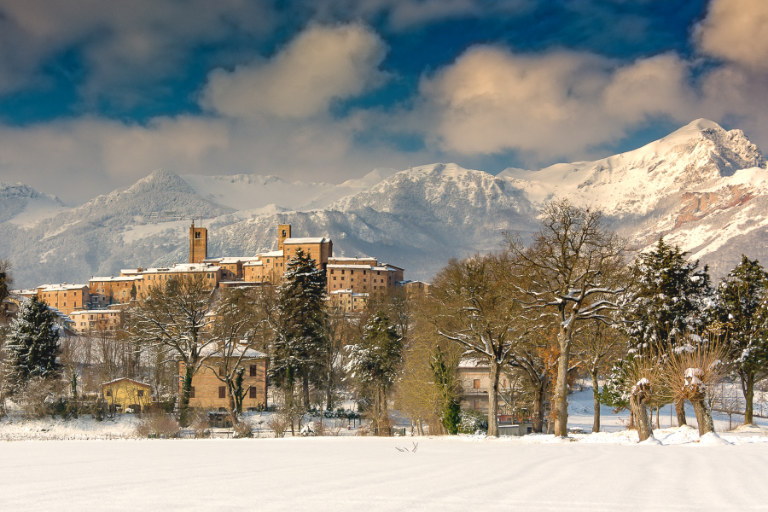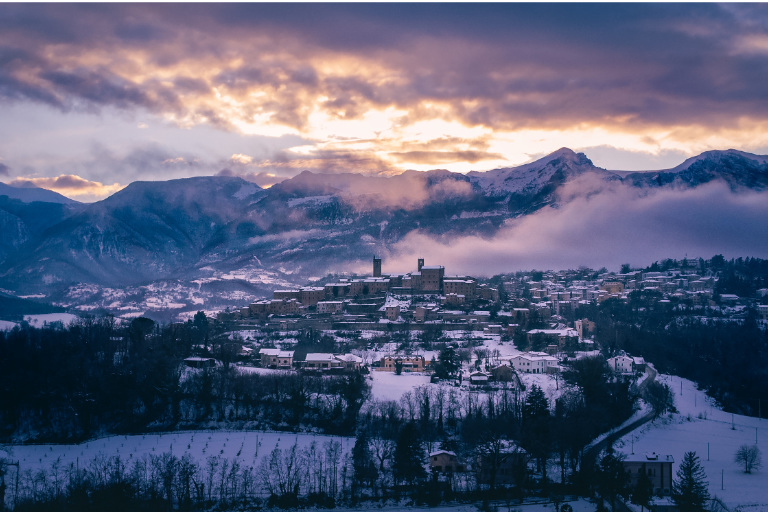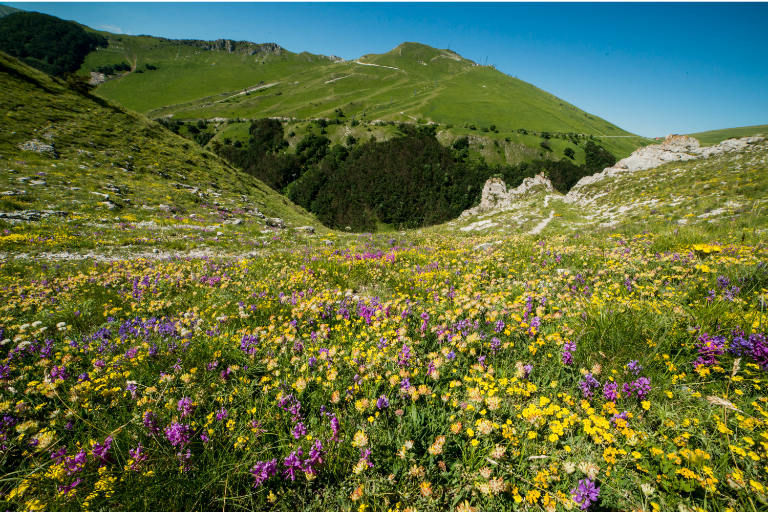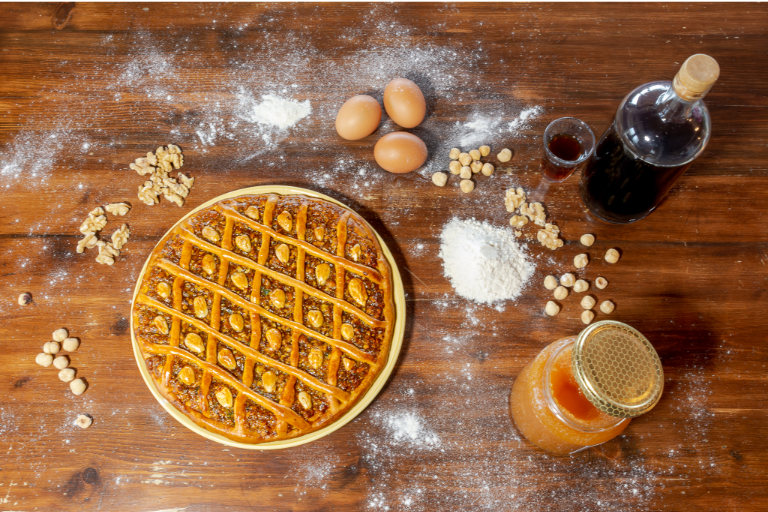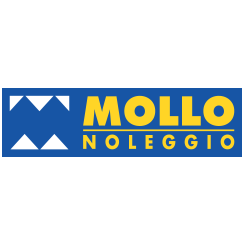profile
map
technical info
This is the toughest stage of the Tirreno-Adriatico, featuring a summit finish. Starting in Morro d’Oro, the route is an endless succession of climbs and descents, linked without pause for breath. The stage passes through some of the most popular locations of the ‘Race of the Two Seas’, such as Offida, Comunanza and Amandala. After taking a first pass through Sarnano, the route takes in successive climbs, with KOM points up for grabs in San Ginesio and Gualdo. The course is very demanding in both course and profile. Overall, the roads are relatively wide and well surfaced to slightly worn out. The closing climb from Sarnano to Sassotetto (14.5 kms) has a 6.5% average gradient, with peaks topping out at 12%.
Final kilometres
The final kilometres correspond to the closing climb leading to Sassotetto. The gradients are quite steady around 6-7%, peaking out above 10% at points, and long straight stretches alternate with hairpins. The gradient decreases shortly before the finish. The home straight is 100 m long, on 7 m wide asphalt, and slightly uphill.
start / finish
final kilometres
itinerary timetable
tourist info
Host city:
Morro d'Oro
Overview
Morro d’Oro, a small town in the Province of Teramo in Abruzzo, rises at 210 m.s.m. on one of the last hills that goes down towards the Adriatic Sea, almost straddling the valleys of the Vomano and Tordino rivers.
The origins of Morro d’Oro date back to the Middle Ages: probably linked to the era of castles (8th-10th century); but, probative news of its existence are not available before a document of 1021, which speaks of a donation made by Adelberto De Aprutio in favor of the monastery of Montecassino and in which appear the holding of Muro and a Castello Veccio is mentioned. Other documents of 1101 and 1128, in which the term Murum (or Morrum) appears, further testify to its existence.
From a geological point of view, clayey areas with local formations of gullies can be seen, more evident in the south-west part of the historic center, which have been enriched with a landscaped walkway suspended in the blank with a breathtaking landscape not to be missed.
For lovers of slow tourism, the territory has a network of itineraries, obtained from the existing rural road system, suitable for mountain bikers but also for walkers and horse riders.
Food
The “Chitarra Teramana con pallottine” is one of the first courses of the culinary tradition of our territory. For those who live in Abruzzo, the “Chitarra (guitar)”, in addition to being a musical instrument, is also an instrument with strings, with which we cut by hands thin spaghetti with a characteristic square shape. A tomato sauce, prepared with “Pallottine” (very small meatballs), enhances the taste of the final meal. The preparation of this recipe is a tradition that dates back to the 1600s, when it was actually invented.
Beans with pork rind: like all typical dishes, “fagioli e cotiche” was born as a peasant and very poor dish: in fact, poor ingredients are used such as pork rind and beans, very simple to cook and at the same time very nutritious. This dish is perfect in the cold months due to its caloric and nutritional content and can become an exquisite single dish if accompanied by crunchy slices of toasted bread.
And then again “fried cheese and mazzarelle”. You cannot leave without having tasted them in our farmhouses.
The farmhouses allow you to experience a holiday in nature, trying the typical products and traditional cuisine of Morro d’Oro. The genuine and zero kilometer ingredients are a guarantee of goodness.
Points of interest
SAINT MARY’S ABBEY (Propezzano)
Abbey of the century VIII founded, according to legend, by three Teutonic Archbishops returning from a pilgrimage to the Holy Land (May 10, 715 AD). Legendary late fifteenth-century incipit of the Atrian Canon Andrea Cerone of an ancient story born, however, by the hands of the disciples of San Benedetto from Norcia. “Diocesi Nullius di Casa Acquaviva” officially since 1478, the Church of Santa Maria had already received four papal bulls: the first in 1300 from Boniface VIII, the second and third from Boniface IX, respectively 1393 (the year of the marriage between Andrea Matteo from Acquaviva and Caterina Tomacelli, his nephew) and 1394, the fourth by Martin V in 1427 which ended the Western Schism. To admire, in addition to the Romanesque style of the Church: the Holy Door (Raimondo del Poggio) which was crossed during the “passes” to acquire plenary indulgences; the quadrangular tower with the bell of the Venetian master founders “Victor et Nicholaus” from 1371; the small porch (narthex) of the vestibule with transcriptions and figures: the most important is that of Mary with the child in her arms and the “cherry” of the dogwood in the lunette above the entrance door.
Adjacent to the Church is the privately owned Monastery “arranged according to the classical structure of the Benedictine building”.
MOTHER CHURCH OF SS. SALVATORE AND SAINT NICOLA (Centro storico)
Recent archaeological excavations have brought to light that: the primitive Romanesque church dates back to the 8th century and was the work of the Benedictine friars; the rebuilding with three naves took place in 1331 by Francesco Acquaviva (father of Matteo and grandfather of Antonio), lord of Morro; the Baroque extension in 1771, partly dismantled with the restructuring of 1933, for of the intervention of the Bourbon government of the time. The Church, also called “Monumental”, has a vast historical and artistic heritage inside. Starting from the various altars, it’s possible to contemplate the Madonna enthroned, the statue of San Bernardo from Chiaravalle, founder of the Cistercian Order, the paintings by Francesco Ragazzini from Ravenna and the anonymous painter of the Lotti school concerning the Assumption of Mary, some busts reliquaries and the statue of San Nicola, co-owner of the Church since 1597 as well as Protector of the entire Municipality of Morro D’Oro. Also to be admired: at the entrance of the churchyard, above the mezzanine, the pipe organ by Adriano Fedri (or Fedeli) from 1757, the year of the extinction of the Duchy of Atri. Under the glass floor, there are grain pits from the Roman era, mass graves and an arcane tomb.
In ancient times (as well as now, but not only) the two thousand-year-old churches were connected by the Brecciola road: an easier route in the first section, up to the ditch; the second one is more arduous which, crossing the “Lands of Purgatory” (Lu Prigadòrij), leads passing over the characteristic gullies to the village. On its way, the Brecciola crosses the Strada Piano de Cesaris which leads to the former Convent of S. Antonio (now a farmhouse): in the past, an intermediate stop on the traditional spiritual journeys in the Morrese area between Old Town- Sant’Antonio – Propezzano.
Sarnano-Sassotetto
Overview
Located on a hill against the background of the Sibillini Mountains, between the Tennacola and Rio Terro rivers, Sarnano, included among “Borghi più belli d’Italia” (Most beautiful villages in Italy) and awarded with Bandiera Arancione (Orange Flag), preserves its medieval town, inside which there is the Civic Art Gallery with works by Vittore Crivelli, Simone De Magistris and Vincenzo Pagani.
Between cultural and sporting events, museums, trekking and biking trails, spas, ski slopes and paragliding, Sarnano offers the perfect combination of art, nature, sport and relaxation. In winter, the ski lifts of Sassotetto and Santa Maria Maddalena welcome ski lovers, while in autumn the caduceus woods around the village are transformed into suggestive itineraries of foliage, in spring the wonderful flowering of orchids blossoms on the Piani di Ragnolo, while summer is perfect for hiking and cycling. Sarnano is also a thermal spa resort known since the 1930s and still operating today with an establishment equipped with therapeutic facilities, a wellness center and residences. Furthermore, it is one of the most renowned hang-gliding and paragliding sites in Italy, thanks to particular favorable air currents almost all year round.
Food & Wine
The gastronomic tradition of Sarnano is linked to the customs of the mountain people and peasant families. On each table you will find multiple reinterpretations of local specialties: simple and genuine dishes, which offer an intense sensory experience, made up of forgotten aromas and flavours.
Start with a slice of fresh bread, rigorously without salt, spread a slice of “ciauscolo” on top, the soft salami, king of local specialties and accompany it with tasty pecorino cheese or delicate ricotta. Don’t miss the lamb offal, seasoned in the most varied ways, then taste the “vincisgrassi”, the Macerata lasagna, or perhaps the “polentone”, cooked in the oven with pecorino, fat and lean or tomato sauce. Or, swirl the fork in a nice plate of “tagliatelle” or “pappardelle” with mushrooms and truffles, or with wild boar, hare or duck sauces. Taste “coniglio alla cacciatora” with herbs from the garden or discover the intense flavor of beans with pork rinds or taste the “erbe strascinate”. Close with a slice of nougat tart, a true Sarnanese uniqueness, prepared with candied fruit and dried fruit mixed with other top secret ingredients, and perhaps accompany it with a glass of long-aged cooked wine. At Easter, taste the donuts without icing, accompanying them with cured meats; at Christmas, lose yourself among the thousand flavors of walnut pizza; in autumn, enjoy the scent of the donut of must to be dunked in new wine and, at Carnival, indulge in a sin of gluttony between “scroccafusi” and “cicerchiata”.
Points of interest
The historic center, the Civic Art Gallery and the ancient library
The village of Sarnano is an open-air museum that recounts the evolution of the town from its foundation in 1265 up to the 18th century, when the fourth and last wall was built. Walking through the alleys and the suggestive little squares you can see the ancient access doors and you can observe architectural structures typical of the Middle Ages such as the “bridge houses”, the “cantilevered houses”, the “doors of the dead” and a still accessible “barbican”. All the streets converge towards the Piazza Alta where the Palazzo del Popolo and the Church of Santa Maria stand, with its astonishing stone portal. Further down, there are the Church of San Francesco with the former Franciscan convent next to it, now the Town Hall, the Library which preserves ancient manuscripts, the Museums of Weapons, Hammers and Birds and the Civic Art Gallery which houses works by Vittore Crivelli , Simone De Magistris, Vincenzo Pagani, Pietro Alemanno, Niccolò di Liberatore called “L’Alunno”, Girolamo di Giovanni and others. All around the historic center rise the mountains of Castelmanardo, Valvasseto, Sassotetto, Pizzo Meta, while in the distance you can see the other peaks of the Sibillini: a panorama of verdant peaks, rocky walls and centuries-old woods that evokes an atmosphere of deep spirituality and connection with nature.
Hiking itineraries
The most popular naturalistic destinations are the peak of Pizzo Meta with its view of the Adriatic Sea, the Cave of Soffiano, a Franciscan hermitage founded in 1101 where Saint Francis himself passed through, the “Tre Santi” Valley, a suggestive path through the woods, streams and rocky gorges, the Rio Terro Valley with its picturesque hidden waterfall and the paths of the “Cammino Francescano della Marca”.
Cycling itineraries and enduro bikes
In the municipal area of Sarnano there are over 100 km of itineraries that can be covered by bicycle, all marked by special signs, divided by length and difficulty. Furthermore, the conformation of the mountains is ideal for trying your hand at adrenaline-pumping disciplines such as the Bike Enduro, to which three different routes have been dedicated.
Way of the Lost Falls (Via delle Cascate Perdute)
One of the most popular itineraries is that of the Via delle Cascate Perdute (Way of the Lost Falls), opened in 2020: a walk of about 6 km starting from the historic center that touches three suggestive waterfalls not far from the village. In the summer of 2021, the hiking route that leads to the “Pozze dell’Acquasanta” and the “Pellegrino” waterfall was also added.
Ski resorts
The Sassotetto and Santa Maria Maddalena lifts offer 11 km of ski slopes, a slope with cable car and tapis roulant, 4 ski lifts, two chair lifts and a snow park.
Hang-gliding and paragliding flight
The Sarnano flight site has a development of about 40 km in a north-south direction and goes from the area of Lake Borgiano to Monte Vettore. The presence of a large flat area that separates the Sibillini from the sea makes it possible to interpret the air and weather conditions with great ease, so much so that it is possible to fly both hang-gliding and paragliding in both summer and winter.In Sarnano there is also a flight school, the first in the Marche region, which organizes courses and tourist flights to be carried out in tandem with the instructor
Thermal Spa of Sarnano
Sarnano has been known since the 1930s for its thermal baths where three types of water flowing from nearby springs are conveyed: the low-mineral “San Giacomo”, the low-mineral bicarbonate-calcium “Tre Santi” and the mineral sulphurous-sauce “Terro”. Since 2017 the Terme di Sarnano, transferred to a new establishment, offers a complete wellness experience: SPA equipped with hydrolife with thermal water, Turkish bath, hydromassage and emotional showers, an outdoor swimming pool with bicarbonate-calcium water and a modern residence equipped with all comforts.


